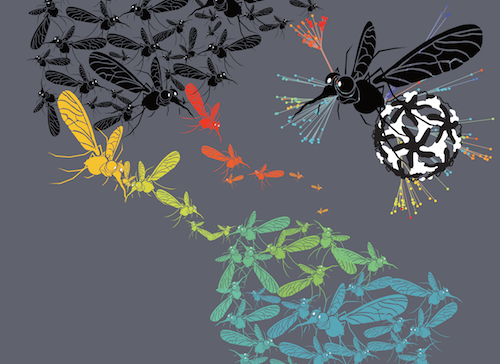Over the past year, we have been privileged to get to work with fantastic colleagues at Oxford, Birmingham, University of São Paulo, FIOCRUZ Salvador, Scripps, USAMRIID and elsewhere on a multiple studies tracing the genomic epidemiology of the Zika epidemic in the Americas. Although manuscripts were posted to bioRxiv in January and February, today sees their formal release in Nature (Faria et al and Grubaugh et al) and Nature Protocols (Quick et al). A fourth paper (Metsky et al) that we were not involved with was also published today.
The paper “Establishment and cryptic transmission of Zika virus in Brazil and the Americas” represents the outcome of of the ZiBRA project, wherein an international team of scientists, lead by groups from Brazil and the UK, traveled across the coast of NE Brazil with a mobile lab to Zika conduct diagnostic surveillance and sequencing. I tagged along for a portion of the trip and mainly helped to sort out bioinformatics and metadata. Later on, Alli flew to Salvador and São Paulo to assist with the final sequencing push. The 53 Zika genomes contributed by ZiBRA project have done much to resolve the origins of the Zika epidemic in the Americas. It is now clear that the Zika epidemic derives from a single introduction into NE Brazil sometime between Aug and Dec 2013. However, the first diagnostically confirmed case of Zika wasn’t until Mar 2015. Thus, there had been over a year of cryptic transmission and by the time Zika was first identified it had already spread throughout much of Brazil.
The paper “Genomic epidemiology reveals multiple introductions of Zika virus into the United States” investigates the only sizable Zika outbreak in the USA that has so far occurred. Last summer, over 250 cases without travel history were reported in Miami-Dade county. In this paper, teams from Scripps and USAMRIID sequenced 29 human cases and 7 pooled mosquito samples from local traps. Gytis played a significant role in the phylogenetic analysis and in investigating travel connections between Miami and Zika endemic areas. I helped with the epidemiological modeling. I was pleased to work out a model to estimate R0 from the degree of clustering observed in the phylogeny along with known case counts. This work showed (at least to me) a surprising degree of clustering and hence significant ongoing local transmission throughout summer 2016. As in Brazil, Zika arrived in Florida earlier than expected from case diagnostics alone. We also observe a strong Caribbean connection in imports of Zika into Miami.
All three groups were fantastic about sharing sequences and I did my best to keep nextstrain.org updated as genomes were released. At this point, Nextstrain shows a comprehensive tree putting all of these Zika genomes (along with others) into a unified context.
Artwork courtesy of Sharon Isern.
